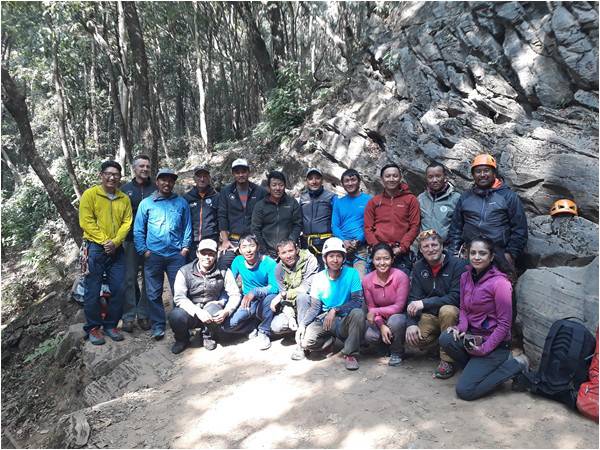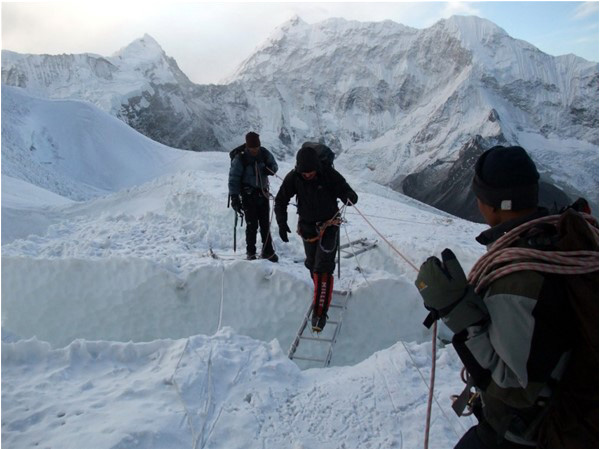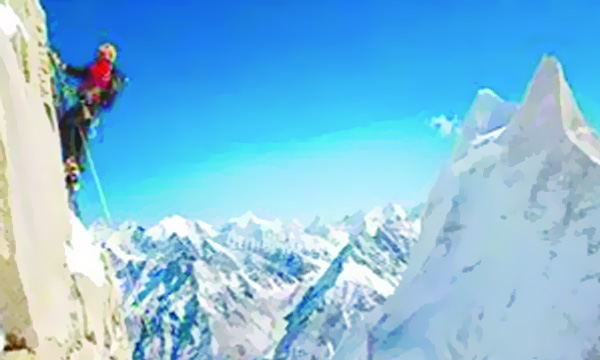
While sitting with a nine-year-old child in a village on a recent trip to Nepal, I was amazed at the coursework that he was studying for an upcoming exam. His notebook was filled with a detailed description of all the natural endowments of the country in a way that I don’t recall from my own school days. Sure, we learn about the mountains and the rivers but never have I seen such passion from a nine-year-old. The respect and love accorded to the mountains and those who work on them is remarkable in the country. It logically follows that perhaps there are some things we can learn from nearby Nepal in order to better develop mountaineering and trekking in Pakistan.
Updating regulations
In December 2017 several amendments were made to the Mountaineering Expedition Regulations in Nepal, reflecting the Department of Tourism’s clear grasp of the changing circumstances on Mount Everest. In the wake of increased deaths on the mountain due to an increasing number of under-experienced climbers as well as solo climbers, foreign climbers will now only be permitted to attempt the assent with experienced local guides. Additionally, any contenders for peaks above 8,000 metres must have scaled at least one 7000-metre peak in the country. The Kathmandu Post also quoted the Tourism Secretary Maheswor Neupane who asserted that there will be a “strict provision to check the medical certificate of the climbers to determine whether they are physically fit to climb the mountains”, a practice that will undoubtedly make the Nepalese mountains much safer for everyone. The updated regulations, in addition to enabling more employment for local staff, also stipulate that Sherpas and local guides will be receiving Summit Certificates – which has been a long-standing point of contention between stakeholders in the past.

Professionalisation of Guiding
Acquiring a mountain guide license is no easy feat in Nepal. In comparison to Pakistan where a guiding license merely requires a trip to the Department of Tourist Services (DTS) in Islamabad, a National Identification Card (NIC), PKR 2,000 and an F.A. exam certificate, passing the Mountain Guide Exam in Nepal is a comprehensive affair. According to the Nepal National Mountain Guide Association (NNMGA) the minimum requirements to enroll for the “Mountain Guide Exam” includes the completion of an “Aspirant Guide Course” (AGC) which has three components. This includes 23 days on the fundamental techniques (alpine rock, ice, and mixed craft), 19 days on rock and theory and 25 days (including 5 days with clients) on theory-plus-snow and mixed modules as well as leading and managing clients. Before the AGC can be attended the hopefuls must give a 3-day entrance exam which tests, among others, the guide’s skills at rock climbing, glacier ascent, traverse and descent, Technical Ice Climbing and a mixed terrain test. Once the AGC is completed the trainees are required to work for two years in order to apply for the Mountain Guide exam.
In addition to the initial training, refresher courses of 3-5 training days must be undertaken by the mountain guides every three years to keep abreast with new skills, tools and regulations. Failure to do so results in the license not being renewed. It is a testament to the vigourousness of the training that only 71 NNMGA certified mountain guides are working currently. To further keep their mountains safe the NNMGA provides “General Training” courses to the public including outdoor medicine as well as rock and ice-climbing skills.
Environmental remediation
In a 2013 article for National Geographic, veteran climber Mark Jenkin labeled the condition of Mount Everest as “Maxed out”. It was estimated that about 50 tons of waste are left on the mountain every year and this is becoming a significant problem. While rubbish can be tackled with regular clean-ups and stricter enforcement of regulations, the removal of human excrement is much more difficult to undertake. One particularly sustainable and innovative initiative, the “Mount Everest Biogas Project” (MEBP) is planning to address this challenge on Everest in the coming years. The MEBP, set to launch in 2019, will employ a high altitude anaerobic biogas digester to treat human waste (estimated by the MEBP to be 12,000 kg of solid human waste per year on Mount Everest). The digester will produce methane which can be used as fuel by the local community and a “pathogen-reduced effluent” which can be used as fertiliser for crops in the valley.
The project is a partnership between Engineers without Borders and Architects without Borders with support from the Gorak Shep Teahouse Owners Association. The initiative is also the winner of the 2017 UIAA – International Climbing and Mountaineering Federation’s Mountain Protection Award.

Rescue and empowerment of local staff
As put by John Ellerton, Director of the Mountain Rescue Council England and Wales “in the Alps, we may be able to expect a helicopter to arrive in 15 to 20 minutes. In the Himalayas that’s not going to happen. It’s going to be hours, there’s going to be organisational issues”. The same is sadly the case for Pakistan – if not worse. However, some initiatives that we can learn from include Sherpa Fit, which is a training program designed specifically to equip Sherpas to carry out rescues and has established the world’s first dedicated Sherpa Rescue Team. This elite team no longer works with clients with their sole purpose being to create a safe climbing environment in Nepal. According to Anthony Gordon, founder of the initiative, it is “designed to bring Health and Wellbeing to Climbing Sherpa and their Mountaineering Clients”. So far they have provided training to over 150 climbing and expedition Sherpa. The aim according to Gordon is to “make prevention better than a cure in the Himalaya”. Their success is apparent with the statistics recently released for rescues on Mount Everest in 2016 when 52 people from various nationalities were rescued. 17.3% of them were discovered and rescued directly by the Sherpa Rescue Team while 65.4% were through their networking.
Previously in 2012 the Institute for Mountain Emergency Medicine and EURAC Education conducted the Nepalese Mountain Rescue Development Project. The project enabled 10 Nepalese guides and 10 Nepalese doctors to train for 2 weeks together as a team in the Alps with more to continue each year till 2017. According to Hermann Brugger, the Head of the Institute for Mountain Emergency Medicine “What we would like is to prepare Nepalese to help themselves to create in the future or to build up in the future their own mountain rescue service so that they will be able to manage their emergencies in Nepal by themselves.”
Initiatives like these, covering the rapidly changing landscape of mountain tourism, will continue to keep it sustainable in Nepal. Perhaps if we can take some of these lessons from a country that has much more traffic on its mountains (in 2016 66,490 people traveled to Nepal specifically for trekking and mountaineering even though the number that fallen to 9,162 after the earthquake in the previous year) we can manage safer and more responsible adventure tourism in Pakistan as well.
Updating regulations
In December 2017 several amendments were made to the Mountaineering Expedition Regulations in Nepal, reflecting the Department of Tourism’s clear grasp of the changing circumstances on Mount Everest. In the wake of increased deaths on the mountain due to an increasing number of under-experienced climbers as well as solo climbers, foreign climbers will now only be permitted to attempt the assent with experienced local guides. Additionally, any contenders for peaks above 8,000 metres must have scaled at least one 7000-metre peak in the country. The Kathmandu Post also quoted the Tourism Secretary Maheswor Neupane who asserted that there will be a “strict provision to check the medical certificate of the climbers to determine whether they are physically fit to climb the mountains”, a practice that will undoubtedly make the Nepalese mountains much safer for everyone. The updated regulations, in addition to enabling more employment for local staff, also stipulate that Sherpas and local guides will be receiving Summit Certificates – which has been a long-standing point of contention between stakeholders in the past.

Professionalisation of Guiding
Acquiring a mountain guide license is no easy feat in Nepal. In comparison to Pakistan where a guiding license merely requires a trip to the Department of Tourist Services (DTS) in Islamabad, a National Identification Card (NIC), PKR 2,000 and an F.A. exam certificate, passing the Mountain Guide Exam in Nepal is a comprehensive affair. According to the Nepal National Mountain Guide Association (NNMGA) the minimum requirements to enroll for the “Mountain Guide Exam” includes the completion of an “Aspirant Guide Course” (AGC) which has three components. This includes 23 days on the fundamental techniques (alpine rock, ice, and mixed craft), 19 days on rock and theory and 25 days (including 5 days with clients) on theory-plus-snow and mixed modules as well as leading and managing clients. Before the AGC can be attended the hopefuls must give a 3-day entrance exam which tests, among others, the guide’s skills at rock climbing, glacier ascent, traverse and descent, Technical Ice Climbing and a mixed terrain test. Once the AGC is completed the trainees are required to work for two years in order to apply for the Mountain Guide exam.
In addition to the initial training, refresher courses of 3-5 training days must be undertaken by the mountain guides every three years to keep abreast with new skills, tools and regulations. Failure to do so results in the license not being renewed. It is a testament to the vigourousness of the training that only 71 NNMGA certified mountain guides are working currently. To further keep their mountains safe the NNMGA provides “General Training” courses to the public including outdoor medicine as well as rock and ice-climbing skills.
Environmental remediation
In a 2013 article for National Geographic, veteran climber Mark Jenkin labeled the condition of Mount Everest as “Maxed out”. It was estimated that about 50 tons of waste are left on the mountain every year and this is becoming a significant problem. While rubbish can be tackled with regular clean-ups and stricter enforcement of regulations, the removal of human excrement is much more difficult to undertake. One particularly sustainable and innovative initiative, the “Mount Everest Biogas Project” (MEBP) is planning to address this challenge on Everest in the coming years. The MEBP, set to launch in 2019, will employ a high altitude anaerobic biogas digester to treat human waste (estimated by the MEBP to be 12,000 kg of solid human waste per year on Mount Everest). The digester will produce methane which can be used as fuel by the local community and a “pathogen-reduced effluent” which can be used as fertiliser for crops in the valley.
The project is a partnership between Engineers without Borders and Architects without Borders with support from the Gorak Shep Teahouse Owners Association. The initiative is also the winner of the 2017 UIAA – International Climbing and Mountaineering Federation’s Mountain Protection Award.

Rescue and empowerment of local staff
As put by John Ellerton, Director of the Mountain Rescue Council England and Wales “in the Alps, we may be able to expect a helicopter to arrive in 15 to 20 minutes. In the Himalayas that’s not going to happen. It’s going to be hours, there’s going to be organisational issues”. The same is sadly the case for Pakistan – if not worse. However, some initiatives that we can learn from include Sherpa Fit, which is a training program designed specifically to equip Sherpas to carry out rescues and has established the world’s first dedicated Sherpa Rescue Team. This elite team no longer works with clients with their sole purpose being to create a safe climbing environment in Nepal. According to Anthony Gordon, founder of the initiative, it is “designed to bring Health and Wellbeing to Climbing Sherpa and their Mountaineering Clients”. So far they have provided training to over 150 climbing and expedition Sherpa. The aim according to Gordon is to “make prevention better than a cure in the Himalaya”. Their success is apparent with the statistics recently released for rescues on Mount Everest in 2016 when 52 people from various nationalities were rescued. 17.3% of them were discovered and rescued directly by the Sherpa Rescue Team while 65.4% were through their networking.
Previously in 2012 the Institute for Mountain Emergency Medicine and EURAC Education conducted the Nepalese Mountain Rescue Development Project. The project enabled 10 Nepalese guides and 10 Nepalese doctors to train for 2 weeks together as a team in the Alps with more to continue each year till 2017. According to Hermann Brugger, the Head of the Institute for Mountain Emergency Medicine “What we would like is to prepare Nepalese to help themselves to create in the future or to build up in the future their own mountain rescue service so that they will be able to manage their emergencies in Nepal by themselves.”
Initiatives like these, covering the rapidly changing landscape of mountain tourism, will continue to keep it sustainable in Nepal. Perhaps if we can take some of these lessons from a country that has much more traffic on its mountains (in 2016 66,490 people traveled to Nepal specifically for trekking and mountaineering even though the number that fallen to 9,162 after the earthquake in the previous year) we can manage safer and more responsible adventure tourism in Pakistan as well.

